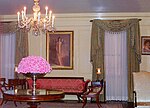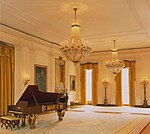White House Library
AC with 0 elementsLibraries in Washington, D.C.Rooms in the White HouseUse mdy dates from May 2019

The White House Library is on the Ground Floor of the White House, the official home of the president of the United States. The room is approximately 27 by 23 feet (8.2 by 7.0 m) and is in the northeast of the ground floor. The Library is used for teas and meetings hosted by the president and first lady. During the 1950s reconstruction of the White House, old building lumber from the house was salvaged and re-made into wall paneling for this room. Several basement rooms in the White House are paneled with salvaged building materials from the pre-reconstructed White House.
Excerpt from the Wikipedia article White House Library (License: CC BY-SA 3.0, Authors, Images).White House Library
Pennsylvania Avenue Northwest, Washington
Geographical coordinates (GPS) Address Website Nearby Places Show on map
Geographical coordinates (GPS)
| Latitude | Longitude |
|---|---|
| N 38.897666666667 ° | E -77.036333333333 ° |
Address
White House
Pennsylvania Avenue Northwest 1600
20500 Washington
District of Columbia, United States
Open on Google Maps











